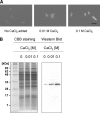Neuronal calcium sensor-1 (Ncs1p) is up-regulated by calcineurin to promote Ca2+ tolerance in fission yeast
- PMID: 20018864
- PMCID: PMC2836045
- DOI: 10.1074/jbc.M109.058594
Neuronal calcium sensor-1 (Ncs1p) is up-regulated by calcineurin to promote Ca2+ tolerance in fission yeast
Abstract
Neuronal calcium sensor (NCS) proteins regulate signal transduction and are highly conserved from yeast to humans. NCS homolog in fission yeast (Ncs1p) is essential for cell growth under extreme Ca(2+) conditions. Ncs1p expression increases approximately 100-fold when fission yeast grows in high extracellular Ca(2+) (>0.1 M). Here, we show that Ca(2+)-induced expression of Ncs1p is controlled at the level of transcription. Transcriptional reporter assays show that ncs1 promoter activity increased 30-fold when extracellular Ca(2+) was raised to 0.1 M and was highly Ca(2+)-specific. Ca(2+)-dependent transcription of ncs1 is abolished by the calcineurin inhibitor (FK506) and by knocking out the calcineurin target, prz1. Thus, Ca(2+)-induced expression of Ncs1p is linked to the calcineurin/prz1 stress response. The Ca(2+)-responsive ncs1 promoter region consists of 130 nucleotides directly upstream from the start codon and contains tandem repeats of the sequence, 5'-caact-3', that binds to Prz1p. The Ca(2+)-sensitive ncs1Delta phenotype is rescued by a yam8 null mutation, suggesting a possible interaction between Ncs1p and the Ca(2+) channel, Yam8p. Ca(2+) uptake and Ncs1p binding to yeast membranes are both decreased in yam8Delta, suggesting Ca(2+)-induced binding of Ncs1p to Yam8p results in channel closure. We propose that Ncs1p promotes Ca(2+) tolerance in fission yeast, in part by cytosolic Ca(2+) buffering and perhaps by negatively regulating the Yam8p Ca(2+) channel.
Figures









Similar articles
-
Fission yeast homolog of neuronal calcium sensor-1 (Ncs1p) regulates sporulation and confers calcium tolerance.J Biol Chem. 2004 Mar 26;279(13):12744-54. doi: 10.1074/jbc.M311895200. Epub 2004 Jan 13. J Biol Chem. 2004. PMID: 14722091
-
Transient receptor potential (TRP) and Cch1-Yam8 channels play key roles in the regulation of cytoplasmic Ca2+ in fission yeast.PLoS One. 2011;6(7):e22421. doi: 10.1371/journal.pone.0022421. Epub 2011 Jul 19. PLoS One. 2011. PMID: 21811607 Free PMC article.
-
Calcineurin responsive zinc-finger-1 binds to a unique promoter sequence to upregulate neuronal calcium sensor-1, whose interaction with MID-1 increases tolerance to calcium stress in Neurospora crassa.Mol Microbiol. 2019 Jun;111(6):1510-1528. doi: 10.1111/mmi.14234. Epub 2019 Mar 25. Mol Microbiol. 2019. PMID: 30825330
-
[Functional analysis of calcineurin-mediated signalling pathway using fission yeast as a model system].Nihon Yakurigaku Zasshi. 2002 Mar;119(3):155-61. doi: 10.1254/fpj.119.155. Nihon Yakurigaku Zasshi. 2002. PMID: 11915517 Review. Japanese.
-
Calcineurin phosphatase in signal transduction: lessons from fission yeast.Genes Cells. 2002 Jul;7(7):619-27. doi: 10.1046/j.1365-2443.2002.00557.x. Genes Cells. 2002. PMID: 12081640 Review.
Cited by
-
Calcium Binding Protein Ncs1 Is Calcineurin Regulated in Cryptococcus neoformans and Essential for Cell Division and Virulence.mSphere. 2020 Sep 9;5(5):e00761-20. doi: 10.1128/mSphere.00761-20. mSphere. 2020. PMID: 32907953 Free PMC article.
-
Compensatory T-type Ca2+ channel activity alters D2-autoreceptor responses of Substantia nigra dopamine neurons from Cav1.3 L-type Ca2+ channel KO mice.Sci Rep. 2015 Sep 18;5:13688. doi: 10.1038/srep13688. Sci Rep. 2015. PMID: 26381090 Free PMC article.
-
Conserved and Diverged Functions of the Calcineurin-Activated Prz1 Transcription Factor in Fission Yeast.Genetics. 2016 Apr;202(4):1365-75. doi: 10.1534/genetics.115.184218. Epub 2016 Feb 19. Genetics. 2016. PMID: 26896331 Free PMC article.
-
Cav2.3 channels contribute to dopaminergic neuron loss in a model of Parkinson's disease.Nat Commun. 2019 Nov 8;10(1):5094. doi: 10.1038/s41467-019-12834-x. Nat Commun. 2019. PMID: 31704946 Free PMC article.
-
Identification of critical amino acid residues and functional conservation of the Neurospora crassa and Rattus norvegicus orthologues of neuronal calcium sensor-1.Genetica. 2016 Dec;144(6):665-674. doi: 10.1007/s10709-016-9933-y. Epub 2016 Oct 31. Genetica. 2016. PMID: 27796528
References
-
- Catty P., Goffeau A. (1996) Biosci. Rep. 16, 75–85 - PubMed
-
- Davis T. N. (1995) Adv. Second Messenger Phosphoprotein Res. 30, 339–358 - PubMed
-
- Okorokov L. A., Silva F. E., Okorokova, Façanha A. L. (2001) FEBS Lett. 505, 321–324 - PubMed
-
- Carnero E., Ribas J. C., García B., Durán A., Sanchez Y. (2000) Mol. Gen. Genet. 264, 173–183 - PubMed
Publication types
MeSH terms
Substances
Grants and funding
LinkOut - more resources
Full Text Sources
Other Literature Sources
Molecular Biology Databases
Miscellaneous

